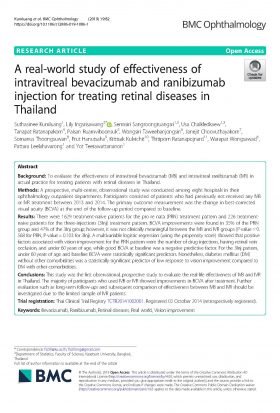This website uses cookies so that we can provide you with the best user experience possible. Cookie information is stored in your browser and performs functions such as recognising you when you return to our website and helping our team to understand which sections of the website you find most interesting and useful.
A real-world study of effectiveness of intravitreal bevacizumab and ranibizumab injection for treating retinal diseases in Thailand

รายละเอียดเพิ่มเติม
Abstract
Background
To evaluate the effectiveness of intravitreal bevacizumab (IVB) and intravitreal ranibizumab (IVR) in actual practice for treating patients with retinal diseases in Thailand.
Methods
A prospective, multi-centre, observational study was conducted among eight hospitals in their ophthalmology outpatient departments. Participants consisted of patients who had previously not received any IVB or IVR treatment between 2013 and 2014. The primary outcome measurement was the change in best-corrected visual acuity (BCVA) at the end of the follow-up period compared to baseline.
Results
There were 1629 treatment-naïve patients for the pro re nata (PRN) treatment pattern and 226 treatment-naive patients for the three-injections (3Inj) treatment pattern. BCVA improvements were found in 35% of the PRN group and 47% of the 3Inj group; however, it was not clinically meaningful between the IVB and IVR groups (P-value = 0.568 for PRN, P-value = 0.103 for 3Inj). A multivariable logistic regression (using the propensity score) showed that positive factors associated with vision improvement for the PRN pattern were the number of drug injections, having retinal vein occlusion, and under 60 years of age, while good BCVA at baseline was a negative predictive factor. For the 3Inj pattern, under 60 years of age and baseline BCVA were statistically significant predictors. Nonetheless, diabetes mellitus (DM) without other comorbidities was a statistically significant predictor of low response to vision improvement compared to DM with other comorbidities.
Conclusions
This study was the first observational, prospective study to evaluate the real-life effectiveness of IVB and IVR in Thailand. The majority of participants who used IVB or IVR showed improvements in BCVA after treatment. Further evaluation such as long-term follow-ups and subsequent comparison of effectiveness between IVB and IVR should be investigated due to the limited sample of IVR patients.
Click here to access the publication: https://rdcu.be/buk1T




